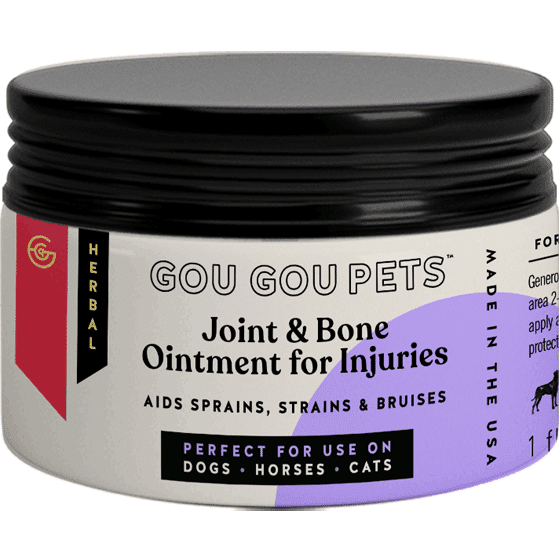
How Do I Know if My Dog Has Joint Pain?
Are you worried about your beloved pooch and whether or not they are suffering from joint pain? Whether your dog is a senior pup or an energetic young one, it's essential to check for any signs that might indicate this discomfort. Joint pain in dogs can be pretty complex because some breeds, like German Shepherds, Labrador Retrievers, and Golden Retrievers, experience more occurrences than others. This blog post will cover the signs and symptoms of joint pain in dogs, how to diagnose it, available treatment options, and how to help your dog live a comfortable life. So if you have any concerns regarding your pet's health, read on!
What Are the Signs of Joint Pain in Dogs?
A combination of changes in behavior and physical symptoms often identifies joint pain in dogs. Joint pain can occur in a variety of forms and can affect different areas of the body. If a dog is experiencing joint pain, it may display various symptoms. These can include:
1: Limping or Difficulty in Standing, Walking, or Jumping-
If your dog appears limping or has difficulty getting up, lying down, and walking or jumping, this can indicate joint pain. This symptom can be caused by several issues, from an injury to arthritis.
Related: Holistic Joint Pain Relief

2: Reluctance to Exercise-
This could signify joint pain if your pet is less enthusiastic about walking or playing as usual. Pain can cause dogs to become less active and tire quickly during activities that are typically not strenuous.
3: Aggression or Irritability-
If your pet becomes aggressive when touched in certain areas, it could be a sign of discomfort. Additionally, dogs with joint pain can become more easily irritated by people and other animals due to the constant soreness in their joints.
4: Unusual Lumps or Swelling-
If you notice any lumps or swollen areas near your pet's joints, this could signify inflammation and joint pain. This symptom is prevalent in dogs with arthritis. This swelling can be accompanied by redness or heat in the affected area.
5: Loss of Appetite-
Dogs experiencing joint pain may lose interest in food and become less motivated. This loss of appetite usually indicates an underlying health issue, such as arthritis or a muscle injury. To help alleviate this joint pain and discomfort, natural joint supplements for dogs can be a great option. These special supplements provide essential nutrients to ease the pain and stiffness associated with joint disease.
Are you looking for joint and pain management for your dog? Gou Gou Pets has a full line of top-quality ointments and sprays available.
How Is Joint Pain Diagnosed in Dogs?
The exact cause of a dog's joint pain is often difficult to diagnose. A veterinarian or veterinary surgeon must perform a physical examination and obtain a detailed pet's medical history to properly diagnose the issue. Additionally, various tests may be ordered, such as:
1: Blood Tests:
This will help tease out any underlying conditions such as infection or arthritis. They may also assess the overall health of your dog, which can provide a better understanding of their condition. Additional tests, such as a urinalysis or biochemistry panel, may be ordered to check for signs of inflammation.
2: X-Rays:
X-ray technology is used to take images of your dog's body inside to provide more detailed information about its joint structure and any potential damage that may have occurred. This is especially helpful in diagnosing conditions such as arthritis or fractures.
3: Ultrasound:
This imaging technique can also assess soft tissues, including the muscles and tendons around the joint. It can help identify pain-causing tears or strains due to injury that may have been undetectable.
4: Joint Fluid Analysis:
In some cases, a sample of the joint fluid may be taken and tested to determine if there is an infection or other problem within the joint. This test helps identify inflammation and can help diagnose conditions such as autoimmune arthritis.
5: Movement Assessment:
The veterinarian may also assess your pet's motion range and how they move. It can help identify any areas that are causing pain or discomfort.
Related: Turmeric Benefits for Your Pets
How to Reduce Dog Joint Pain?
Dog joint pain is a common problem for many canine companions, and various treatments are available to reduce its discomfort. Let's take a look at some of the ways you can help your pup feel better.
1: Provide Supportive Bedding–
One of the best things you can do to help reduce joint pain is to provide comfortable and supportive bedding for your dog. Orthopedic beds are beneficial, as they are designed to provide extra cushioning and support for joints and other pressure points. Consider investing in an orthopedic bed for your pup, or add a few extra pillows to their existing bed for additional comfort.
2: Exercise Regularly–
Keeping your pup active is essential for reducing joint pain and keeping their body healthy. Regular walks, playtime, and even swimming can all help keep joints strong and mobile. However, be sure not to over-exercise your pup and follow the guidelines for their age, size, and breed.
3: Maintain a Healthy Weight–
Excess weight puts added stress on joints and can worsen the symptoms of joint pain, so it's essential to maintain a healthy weight for your dog. Monitor their eating habits to ensure they don't overeat, and speak with your veterinarian about a healthy diet plan if necessary.
4: Medicinal Treatments–
If your pup's joint pain persists, you may need to consider medicinal treatments. Various medications are available to reduce joint pain and inflammation, as well as joint supplements that can help maintain healthy joints. Let's discuss options that are best for your pup.
-
Use Ointment–
If your pup's joint pain is mild to moderate, you may want to consider applying ointment. It can help reduce discomfort and inflammation associated with arthritis or other joint issues. Gou Gou Pets Joint & Bone Ointment is one of the best ointments for joint support for dogs, joint meds for dogs, and natural joint supplements. This all-natural remedy helps relieve joint and bone injuries in dogs, cats, and horses. It is developed with highly concentrated natural ingredients, and this ointment increases blood flow to reduce swelling and support tendon and bone health. Best of all, it has no scent or greasiness and will not stain clothes or bedding. Give your pet the relief they need with Gou Gou Pets Joint & Bone Ointment.

-
Use Anti-Inflammatory Shampoo–
If your pup's joint pain is more severe, you may want to consider using an anti-inflammatory shampoo or natural dog joint supplements. These shampoos contain natural ingredients like tea tree oil and aloe vera that soothe skin and reduce inflammation, as well as powerful hip and joint for dogs supplements to help promote better mobility. One of the best anti-inflammatory shampoos to try is Gou Gou Pets' Anti-Inflammatory Shampoo, a revolutionary product designed to help ease joint inflammation and joint aches in cats, dogs, and horses. This herbal shampoo contains only naturally derived active ingredients and no artificial materials. It's also sulfate-free, cruelty-free, eco-friendly, biodegradable, and made in the USA to GMP standards. With Gou Gou Pets, you can trust that your pet is getting the best quality care possible. Give your pet a healthier life today with an Anti-Inflammatory Pet Shampoo from Gou Gou Pets.
5: Diet–
A balanced diet is also vital for maintaining joint health. Certain foods can help to reduce inflammation and ease pain while providing the necessary nutrients to support joint health. A veterinarian or a nutritionist may be able to advise on dietary changes that would benefit dogs with joint pain.
Share
